A History of the County of Berkshire: Volume 4. Originally published by Victoria County History, London, 1924.
This free content was digitised by double rekeying. All rights reserved.
'Parishes: East Hendred ', in A History of the County of Berkshire: Volume 4, ed. William Page, P H Ditchfield (London, 1924), British History Online https://prod.british-history.ac.uk/vch/berks/vol4/pp294-302 [accessed 14 March 2025].
'Parishes: East Hendred ', in A History of the County of Berkshire: Volume 4. Edited by William Page, P H Ditchfield (London, 1924), British History Online, accessed March 14, 2025, https://prod.british-history.ac.uk/vch/berks/vol4/pp294-302.
"Parishes: East Hendred ". A History of the County of Berkshire: Volume 4. Ed. William Page, P H Ditchfield (London, 1924), British History Online. Web. 14 March 2025. https://prod.british-history.ac.uk/vch/berks/vol4/pp294-302.
In this section
EAST HENDRED
Henret (xi cent.); Henred, Hanred, Esthanreth (xiii cent.).
The parish of East Hendred has an area of 3,061 acres, of which 1,502 are arable land, 520 permanent grass and 81 woods and plantations. (fn. 1) It stretches from the low ground near the Great Western railway to a point called Hendred Knoll on the West Ilsley and Farnborough Road. About a mile to the north, and adjoining the Ridgeway on the south side, is Cuckamsley Knob ('Cwichelmeshlaew,' 1006), probably the burial mound of King Cwichelm of Wessex. Various root and cereal crops are raised, and there is good pasture on the high down land. The soil is Chalk and Loam, on a subsoil of Chalk in the south of the parish, Greensand in the centre and Blue Gault towards the north. A chalk-pit on the downs provides material for the repair of the roads.

Plan Of The Chapel Of Jesus Of Bethlehem
In the boundaries of the king's manor, (fn. 2) which were ascertained in 1607, the jurors included the manors of Arches, Framptons and New College. The excluded part was the land in the east part of the parish called Kinmanside which probably formed the manor of Reading Abbey. Part of it is still called Abbot's Heath.
The weekly market and two fairs here, granted by Henry V to the Prior of Sheen, (fn. 3) never flourished; the former seems to have disappeared altogether before the Dissolution, (fn. 4) and there is now no trace of the fairs beyond a yearly 'feast' held on the green on the Sunday before Whitsuntide and the three following days; this possibly represents St. Augustine's fair. The clothing industry was important in the 15th century, (fn. 5) and tradition associates with it certain grass terraces in the centre of the village, while a green road known as the 'Golden Mile' is supposed to be the site of the old cloth fairs.
The village, which is among the most picturesque in the county, contains numerous thatched and halftimbered cottages of the 16th and 17th centuries. One of these, built early in the 16th century, has herring-bone brick filling and a gable at each end with oak barge-boards panelled with a succession of quatrefoils. The rectory, opposite the church, was originally a timber-framed house, but was enlarged in red brick about a century ago. In the garden are some remarkable yew hedges. On the village green stands the early 15th-century chapel of Jesus of Bethlehem, built by the monks of Sheen, now desecrated and disused. It acquired the name 'Champ's Chapel' from the family which held it in the early 18th century, when the upper part was used as a pigeon-house, the lower part as a bake-house and wash-house. (fn. 6) Its late owner, Mr. George Dunn, had it cleared and repaired. It is now the property of his trustees. It is a small rectangular building faced with rough ashlar, 25½ ft. by 15¼ ft. internally, with a priest's house adjoining it on the north side. The east window is of three lights with tracery in a pointed head. At the east end of each side wall is a square-headed window of two cinquefoiled lights; below that on the north is a modern doorway and below the southern one a square locker. Further west on the north side is a blocked arch of brick representing a doorway to the later priest's house, and above it is a stone-headed doorway at the first-floor level. Towards the west end of the south wall is a rectangular blocked opening of doubtful use. In the west wall is a four-centred doorway, and above it a square-headed window of two cinquefoiled lights. The chapel is divided internally by an oak screen with a central doorway and five bays on either side with rounded heads; the beam supports a floor dividing the western part of the chapel into two stories, the upper room communicating with the priest's house and being screened off at the east end by a close timber partition. Flanking the east window at a lower level are two stone brackets. The high-pitched roof has curved principals and wind-braces.
The late 15th-century priest's house is a timberframed building adjoining the western half of the chapel; the upper story formerly overhung on the north and west, but has been underbuilt with modern brick. The gable is half-timbered and the bargeboards are enriched with flowing blind tracery. At the first-floor level is a four-light window with rounded heads and a stone fireplace with a four-centred opening and square head. The roof is tiled and has curved principals and wind-braces similar to those in the chapel. About 1690 the house was extended further east and now overlaps the chapel at this end, blocking the north window; the end wall is of stone with brick angles. Opposite the chapel, on the west side of the green, is a range of stone outbuildings, probably of early 16th-century date, with an entrance archway.

Hendred House: The West Front
The manor-house of Arches, the residence of the Eyston family, called Hendred House, lies to the south of Champ's chapel, and was apparently in H-shaped building to which a 19th-century block was added at the back, making the plan quadrangular. It is two stories high and faces west. The exterior has been plastered over and there is little indication of the date. The chapel, however, has traces of 13th-century work and the hall in the main block is probably of the 15th century. Its roof is now ceiled in and a modern gallery is carried along the east side. The fine 15thcentury fireplace has a moulded four-centred arch and a panelled frieze. The chapel, forming the east end of the south wing, has diagonal buttresses at the east angle and a two-light east window of 'Decorated' character. In each side wall is a lancet window, somewhat altered, but apparently of 13th-century origin, and the four-centred south door is probably of the 15th century. Other windows are modern, and there is a gallery at the west end. Some roundels of 17th-century foreign glass remain in the windows, including a Crucifixion, St. Luke and St. Nicholas, and on the north are initials said to be those of Hugh Faringdon, Abbot of Reading. This is said to be one of three chapels in England built before the Reformation which have never been used for Protestant services. It was rifled and desecrated in 1688.
The manor of Framptons also possessed a manorhouse, most of which was pulled down before 1802. (fn. 7)
Frampton's Farm, at the south end of the village, is perhaps on its site. A corn-mill on the small stream which flows past the village probably represents the mill which has been attached to the manor of Framptons since the time of the Domesday Survey. (fn. 8) In 1403 it was called Litelbrygge Mill. (fn. 9) The small bridge just below it, at the point where the Portway crosses the brook, is now known as Ludbridge.
Downside House, on the outskirts of the village, has two good stone windows of Elizabethan character set in the ashlar wall of an outbuilding, but probably not in situ. The house itself is of red brick.
At the beginning of the 19th century the courts of the king's manor were held in a cottage just opposite Champ's chapel. (fn. 10) A hundred and fifty years earlier they had been held under a tree in the village. (fn. 11)
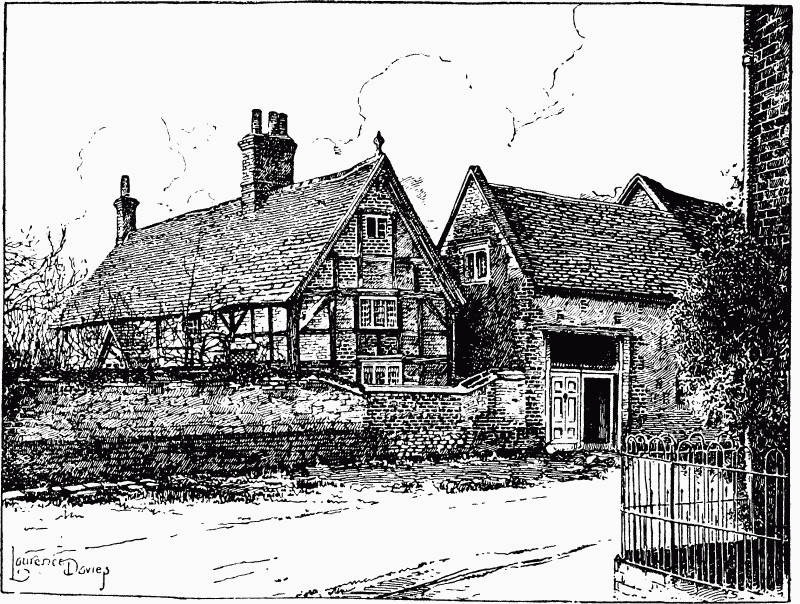
The King's Manor, East Hendred
The Roman Catholic church of St. Mary, built in 1865, is a stone building in the 14th-century Gothic style, consisting of chancel, nave and north aisle, and connected by a half-timber gallery with the presbytery. In the churchyard is a modern cross.
The village also possesses a Primitive Methodist chapel. There are elementary schools for both Protestants and Catholics.
The part of the parish called Westmanside was inclosed by an Act of 1801. (fn. 12)
Manors
The KING'S MANOR of East Hendred consisted of 10 hides, of which 5 were held in the reign of the Confessor by Alvin and the other 5 by seven freemen. (fn. 13) At the Conquest all ten were given to the Count of Evreux, who had an estate here in 1086 worth £5. (fn. 14) He granted it with his other lands in England to the Norman priory of Noyon, (fn. 15) to which it remained attached till the confiscation of the n dowments of the house by Henry V. In the early 13th century William de Wenham was holding this manor of the prior. It was claimed against him unsuccessfully in 1225 by Peter de Chewehurst, (fn. 16) who quitclaimed to the prior in 1228. (fn. 17) It must, however, have escheated or been surrendered by William de Wenham to the priory, since it was held in demesne shortly afterwards. (fn. 18)
On the dissolution of alien priories the possessions of Noyon were granted to the Surrey monastery of Sheen. (fn. 19) In 1415 the Prior of Sheen had a grant of a weekly market in East Hendred on Tuesday, and two fairs lasting for two days before the feasts of St. Augustine (26 May) and St. Katherine the Virgin (25 November), the feasts themselves and the day following. (fn. 20) He received at the same time the privileges of freedom from toll, assize of bread and wine, free warren, infangenthef and outfangenthef, sac and soc, the pillory and the tumbrel. (fn. 21)
At the Dissolution the manor was once more vested in the Crown and remained so vested down to the 19th century. John Addis, who held a court here in 1641, was presumably a lessee. (fn. 22) It was sold in 1833 to Mr. John Allin, whose family held it till 1897, (fn. 23) when it was purchased by Mr. Hall. The present owners are the trustees of the late Mr. George Dunn. (fn. 24) The stewardship of the manor as 'an office of honour and profit' was granted to members of parliament to enable them to vacate their seats. (fn. 25)
The ABBEY MANOR was royal demesne in the reign of Edward the Confessor and for some time after the Conquest. It consisted of 4½ hides of land. (fn. 26)
This manor was granted by the Empress Maud to the monks of Reading Abbey, (fn. 27) and the grant was confirmed by her successors. (fn. 28) A farm of £5 paid by the abbot for this manor was granted before 1291 to the alien priory of Ogbourne (Wilts.). (fn. 29)
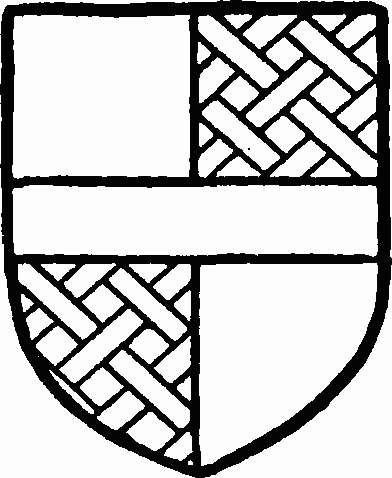
Norreys. Argent quartered with gules fretty or a fesse azure over all.
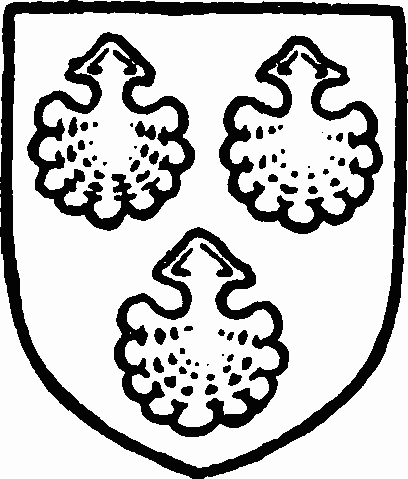
Reading Abbey. Azure three scallops or.
At the Dissolution the manor passed to the Crown, and John Stoner was appointed bailiff of this and other Reading manors in 1540. (fn. 30) It was granted in 1544 to Henry Norreys and Margery his wife in tail male. (fn. 31) His descendants (fn. 32) held it till 1622, when Thomas Norreys Earl of Berkshire conveyed it to Sir Peter Vanlore. (fn. 33) He sold it in the next year to William Eyston, (fn. 34) lord of the manor of Arches, which it thenceforth followed in descent.
In the reign of Edward the Confessor Godric the king's sheriff held a hide of land in East Hendred. (fn. 35) This in 1086 was in the hands of Henry de Ferrers, though the wife of Godric claimed that King William had given it to her for supporting his hounds. Only Alvric de Thatcham, however, supported her claim in the hundred court, and Henry de Ferrers remained in possession. (fn. 36) This holding, which developed into the manor of ARCHES, formed part of his honour of Tutbury, which the overlordship followed in descent. (fn. 37) A mesne lordship in the manor belonged to the family of Hussey of Standen Hussey (fn. 38) (q.v.).
From the middle of the 12th century at least the tenants were the family of Turberville. John de Turberville was holding a fee in the honour in 1166, (fn. 39) and witnessed an Abingdon charter of rather earlier date. (fn. 40) The Geoffrey de Turberville who granted land to Poughley Priory before 1248 (fn. 41) was perhaps his successor. Robert de Turberville held this manor in the middle of the 13th century, (fn. 42) and was a contemporary of John de Turberville, who held land at the same time in Catmore (q.v.). John, who was perhaps the son of Robert, and seems to have succeeded him, (fn. 43) exchanged land here with the Abbot of Reading in 1259. (fn. 44) He died in or about 1267 and was succeeded by his son Richard de Turberville, who was in possession in 1278. (fn. 45) Richard had a son also called Richard and a daughter Amice, (fn. 46) who married first William de Arches and secondly Rogo de Gacelyn. (fn. 47) He seems to have settled this manor, however, on Geoffrey de Turberville, perhaps a nephew. Geoffrey was succeeded by Amice, who is described as his cousin and heir. (fn. 48) The manor was settled on Amice and her second husband and their heirs in 1308, with remainder to her son William de Arches. (fn. 49) It was taken into the king's hands for the rebellion of Rogo in 1322, (fn. 50) but was subsequently restored, and remained for several generations in the hands of the Arches family, taking its name from them. William was succeeded by John de Arches, probably his son, on whose heirs the manor was settled in 1375. (fn. 51) He was living in 1401, when he was a justice of the peace for Berkshire, (fn. 52) and was succeeded by Ralph or Rawlin de Arches, (fn. 53) escheator for the county in 1412. (fn. 54) He was dead in 1421, when his widow Elizabeth and his daughter Maud wife of John Stowe were both claiming his manor of Catmore. (fn. 55) Maud inherited Arches, and seems to have married as her second husband William Crossby, (fn. 56) who did homage for the manor in 1439. (fn. 57) She had a daughter and heir Isabel Stowe, who married John Eyston (fn. 58) and carried the manor of Arches into his family.
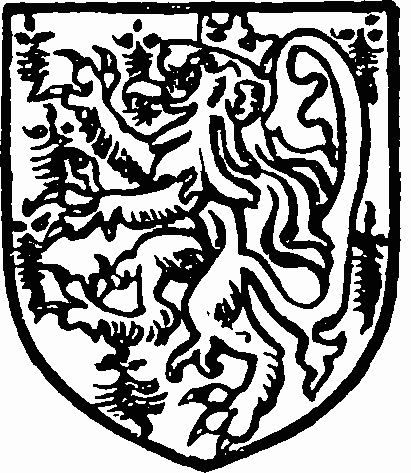
Turberville. Ermine a lion gules crowned or.
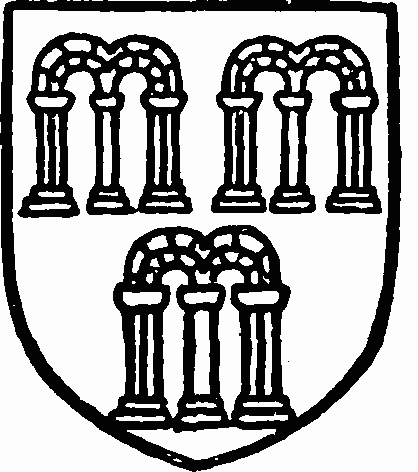
Arches. Gules three arches argent.
John Eyston had a son and heir William, (fn. 59) who died in 1494, leaving a son Thomas. (fn. 60) The latter was succeeded in 1531 by his son John, (fn. 61) who died in 1545, (fn. 62) when his son John, a minor, was his heir. (fn. 63) The younger John settled the manor in 1583 on his third wife Jane daughter of Thomas Berington (fn. 64) and died six years later. (fn. 65) His widow became Mrs. Arden and held the manor for life. (fn. 66) Her son and heir William Eyston was the next lord, (fn. 67) and was succeeded by a son, also called William. (fn. 68) The younger William had a son and heir George, (fn. 69) who was living in 1665–6. (fn. 70) George was succeeded by his son Charles, (fn. 71) whose son and heir, also called Charles, was in possession in 1725. (fn. 72) The latter died without issue, and was succeeded by his brother Thomas John Eyston, (fn. 73) who had a son and heir Basil. (fn. 74) Basil had a son Charles, a grandson Charles John, and a great-grandson Thomas More Eyston, who inherited the manor in turn. (fn. 75) John Joseph Eyston, brother of Thomas More, is the present lord.
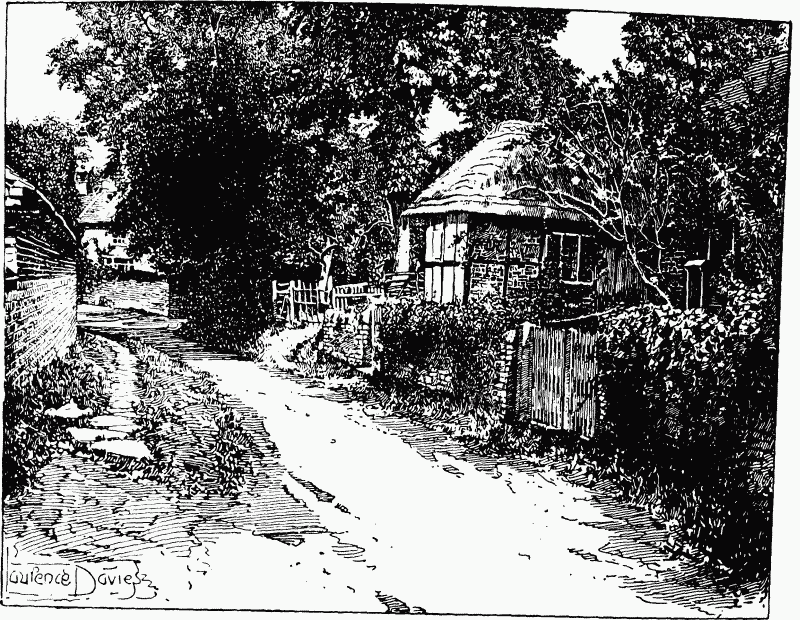
East Hendred: A View In The Village
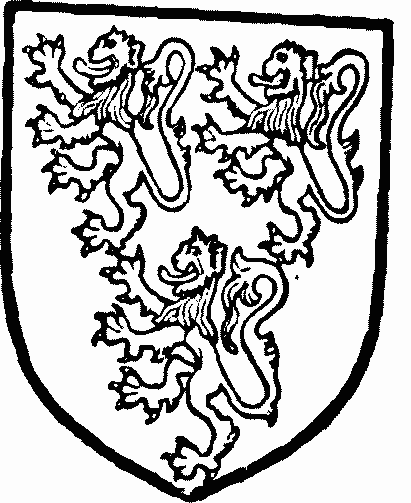
Eyston. Sable three lions or.
The manor of FRAMPTONS, which included 7 hides of land, was held before the Conquest by a freeman Sawin. In 1086 it was in the hands of a thane Cola. There were eight cottars here and a mill worth 20s. (fn. 76)
The successors of Cola were the family of Marmion. Robert Marmion gave the tithe of his demesne here to Abbot Rainald of Abingdon (1084–97). (fn. 77) His son Helto (fn. 78) gave the manor to the abbey of St. Stephen Caen, (fn. 79) and the grant was confirmed by William the Conqueror. (fn. 80) It was subsequently attached to the priory of Frampton in Dorsetshire, (fn. 81) a cell of St. Stephen's, (fn. 82) and so acquired its distinctive name. In 1410 John Duke of Bedford had licence to acquire from the parent houses in Normandy the temporal possessions of the priories of Frampton and Ogbourne. (fn. 83) Henry V probably confirmed his estate in them on the dissolution of alien monasteries in the second year of his reign. (fn. 84) The duke died in possession of the manor in 1435, (fn. 85) leaving the king as his heir. How long after this date Framptons remained in the Crown is not quite clear. At the Dissolution it was and had been since 1516 at least in the possession of the priory of Bradenstoke (Wilts.). (fn. 86) Its value in 1541 was £8 13s. 4d. (fn. 87)
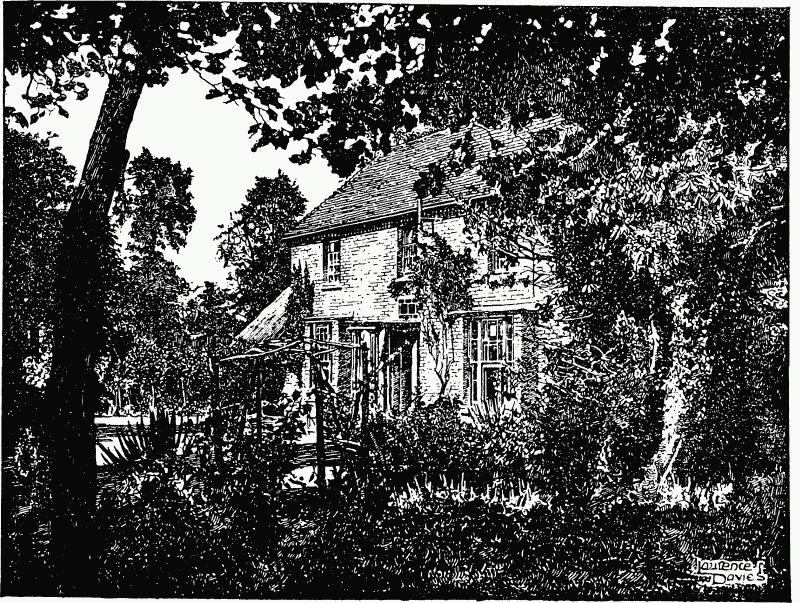
The Manor House, East Hendred
In 1554 Philip and Mary granted the manor to Thomas Everard and Richard Yate for life, with remainder to Thomas Booth and Nicholas Booth. (fn. 88) Thomas Everard released his right to Nicholas Booth in the same year. (fn. 89) The manor was granted by Nicholas Booth in 1570 to Edward Young and his wife Elizabeth and Francis Young his son in tail, with remainder to Anne Sherwood, daughter of Edward, and her heirs. (fn. 90) Francis must have died without issue, for Anne inherited. Her husband John Sherwood was in possession in 1610. (fn. 91) They had a son and heir Edward, (fn. 92) who was succeeded in 1642 by his son John. (fn. 93) The latter was living in 1665–6. (fn. 94) and had a son Edward. (fn. 95) Mary, the daughter and heir of Edward, married George Cooper, M.D., and died a lunatic and intestate in 1788. (fn. 96) The manor then reverted to the representative of Edward Sherwood, a younger son of the first Edward. This was Sir John Pollen, bart., whose grandmother Mary was a daughter of Edward Sherwood. (fn. 97) It was sold in 1822 by his son Sir John Walter Pollen (fn. 98) to John Allin, (fn. 99) and was purchased in 1897 by Lord Wantage on the sale of the estates of John Allin's grandson. (fn. 100) Mr. A. K. Loyd, to whom the manor was conveyed by Lady Wantage in March 1912, is the present owner. (fn. 101)
NEW COLLEGE MANOR must be identified with the hide of land in East Hendred which in 1086 was held of the king in alms by Ældeva, a free woman. (fn. 102) She had been the tenant before the Conquest. (fn. 103) This hide of land was granted by Richard I to John de Edgareston to hold for life. (fn. 104) He gave his interest in it to the Prioress and nuns of Littlemore, to whom in 1232 the king granted this estate to hold of his gift for ever. (fn. 105) After the Dissolution the manor came into the possession of John Lord Williams, (fn. 106) and was left by him as part of the endowment of the grammer school at Thame. (fn. 107) In 1575 his executors granted these endowments to the Warden and Scholars of New College, Oxford, as trustees for the school. The college held the East Hendred manor till the end of the 19th century, when the trust was taken over by the Charity Commissioners. The Prioress of Littlemore claimed the assize of bread and ale here in the 13th century. (fn. 108)
Three hides in Hendred were granted by Edgar to Abingdon Abbey (fn. 109) and were held till the middle of the 13th century by the St. Helen family. (fn. 110) This holding probably came into the possession of John Southbury of Wantage, who granted two messuages, a mill, and about 200 acres here in 1397 to Roger Walden, Archbishop of Canterbury, and John his brother. (fn. 111) They conveyed it two years later to the king, who granted it at once to the Abbot and convent of Westminster. (fn. 112) The land which was granted to Poughley Priory by Geoffrey de Turberville (fn. 113) was given to the abbey at Westminster after the Dissolution and subsequently became the property of the dean and chapter. (fn. 114)
In 1086 a hide and a half of land in East Hendred were held by Tori of the Bishop of Salisbury, to whose overlordship he had commended himself. (fn. 115) In the first half of the 13th century this estate was held of the bishop by John de Hendred, (fn. 116) in 1324 by Thomas de Abberbury, (fn. 117) and in 1347 by John de Abberbury. (fn. 118) Richard de Abberbury (fn. 119) had licence in 1365 to grant six messuages and half a carucate to two chaplains in a chapel to be built by him at Donnington. (fn. 120) In 1376 this grant was assigned to the Friars of the Holy Cross or Crutched Friars, near the Tower of London, with the obligation to support the chaplains. (fn. 121) The Abberburys had the right of re-entry if chaplains were not appointed, and the nephew of Richard exercised it in 1448 (fn. 122); he afterwards granted the premises to William Duke of Suffolk. (fn. 123) The duke died in possession, (fn. 124) but it seems probable that some of the land was afterwards granted to the priory of Crutched Friars at Donnington. This priory possessed at the Dissolution a messuage here and land called 'Church Howse land,' which in 1540 was granted to Edward Fettiplace in fee. (fn. 125) He had licence to alienate it in the next year to John Coxhed and his heirs. (fn. 126) In the reign of Elizabeth these lands belonged to Humphrey Forster of Aldermaston, who sold them in 1587 to William Doo. (fn. 127) The latter died in possession, but there is no further evidence as to the history of the estate.
One virgate of land in East Hendred was held in 1274 by Ralph son of Thomas de Hendred by the service of a daily Pater Noster for the souls of the Kings of England. (fn. 128) He was succeeded by his son John, (fn. 129) who died about 1302, leaving a brother and heir Richard. (fn. 130) This Richard or his heir of the same name had licence in 1360 to settle the land on himself with remainder to Robert Cole. (fn. 131) Alice daughter of Robert Cole granted it in 1400 to John Hychecokkes. (fn. 132) There is no evidence as to its subsequent history. The piece of land, the name of which survived in a road called Paternoster Bank, was still to be identified in the early 18th century. (fn. 133)
Church
The church of ST. AUGUSTINE OF CANTERBURY consists of a chancel 31 ft. 9 in. by 19 ft. 6 in., nave 54 ft. by 18 ft. 9 in., north vestry and organ chamber, south chapel 22 ft. 3 in. by 11 ft. 6 in., north transept, north aisle and two south aisles, making a total width of 46 ft., and a west tower 15 ft. by 14 ft. The measurements are all internal.
The earliest existing work is the south arcade of the nave, which dates from the late 12th century. The north arcade was built shortly afterwards. In the 14th century the north aisle was rebuilt and the north transept added; the chancel was probably rebuilt at the same time. In the 15th century the west tower was built, the south chapel and an outer south aisle of two bays added. The church was extensively restored in the 19th century, when the east wall was rebuilt, the organ chamber and vestry added, the old south porch was taken down and the outer south aisle extended to the west end; the clearstory was also largely rebuilt.
The chancel has a modern east window and two modern arches in the north wall opening into the organ chamber. In the south wall is a 14th-century piscina with an acutely-pointed head and cinquefoiled tracery below it; it has a shelf and a semi-octagonal projecting bowl. Further west is a modern window and sedilia and two 15th-century arches opening into the south or Eyston chapel; the arches are fourcentred and have semi-octagonal responds and a modern quatrefoil column with ancient capital and base. In the east wall of the modern organ chamber is a 15th-century arched recess, probably the rear arch of a window, with small panelled buttresses at the sides terminating in carved heads which form the stops of the label. The chancel arch of wood is modern, but the semi-octagonal responds with moulded capitals and bases are of the 15th century. The Eyston chapel has a square-headed cast window of three lights with tracery of the 15th century. In the south wall are two smaller windows also of three lights and of similar character; below the eastern is a small pointed piscina. The walls have flint and stone chequerwork externally.
The nave has a late 12th or early 13th-century north arcade of four bays, considerably restored. The columns are cylindrical with handsome carved foliage capitals, all different, and square responds with modern moulded capitals; the arches are pointed and of one chamfered order and have a label on the nave side. The south arcade is similar, but of slightly earlier date. The column capitals with stiff-leaf foliage are all unrestored, and the third capital has a carved head. The arches have labels with head stops on each side. The clearstory has four almost triangular-shaped cinquefoiled windows on each side; all are modern except the western window on the north. The 14th-century north transept has a good three-light north window with flowing tracery. In the west wall is a half arch of the 14th century opening into the north aisle. The north aisle has two windows, the eastern modern and the other of the 14th century with two lights and a quatrefoil in the head; between them is the north doorway. The south aisle has an outer arcade of four bays of 15th-century character, but only the two eastern bays are original; the first column is octagonal, but has a modern capital. The outer wall is entirely modern and has a small projection to the east bay forming a south transept.
The 15th-century tower is of three stages, the two lower faced with ashlar and the upper partly of rubble; the parapet has pierced quatrefoils with pinnacles at the angles and the buttresses are diagonal. The tower arch is pointed and of three hollowchamfered orders, the inner only interrupted by moulded capitals and the others continuous. The west window is pointed and of four lights, and below it is a door with a four-centred head and a label with voluted stops. The floor of the second stage is framed round a bell way, and in three sides are single-light trefoiled windows. The bell-chamber is lighted by a two-light pointed window in each face.
The roof of the chancel is of the trussed rafter type, and over the sacrarium has a boarded soffit with moulded ribs and carved bosses at the intersections, mostly foliage, but including a lion, an eagle, the initials T.C. and shields, lozengy ermine and —and a lion. The 14th-century nave roof has heavy tie-beams and short king-posts with capitals and struts; above the former rood-loft is one bay of flat panelled boarding with ribs. The lead covering is inscribed 'J. Cowdrey, W. Beasley, churchwardens 1798.' The Eyston chapel has a 15th-century tie-beam roof with moulded main timbers and embattled wall-plates, and that over the south aisle is similar and continuous; over the outer arcade is a deep moulded and embattled beam. The north transept has a low-pitched gabled roof with moulded main timbers.
In the Eyston chapel are numerous floor slabs, mostly of early 18th-century date, to members of the Eyston family. On the south side is a brass to John Eyston, who died in 1589, and Jane (Berington) his third wife, with figures, the man in plate armour, four sons and one daughter, and two shields of arms, the first Eyston quartering Stowe, Arches and Turberville, and the second the same impaling three collared greyhounds with a crescent for difference, for Berington. A black and white marble slab commemorates William Thatcher, 1620 (or 1626), with his arms, Gules a cross moline argent and a chief argent with three grasshoppers azure therein quartering the three cheverons of Lewknor. In the north transept is a brass inscription to William Whitwey, 1479, 'pannarius et lanarius,' and a second brass to Henry and Roger Eldysley, brothers (the latter died in 1439), merof this town; only one figure is left with two merchants' marks.
The font has a plain octagonal bowl. The pulpit, a rich piece of Jacobean work, is octagonal with carved foliage and conventional panels with head bosses, and the sounding-board has enriched arches with pendants to each face and a dentilled cornice; the modern support at the back incorporates four old carved panels. The remarkable oak lectern is of the 15th century or perhaps earlier. The stem, which is terminated with a carved foot standing on three winged dragons, one partly restored, has panelled faces and two book-rests, one for kneeling and one for standing; the upper one has the spandrels carved with foliage crooks; the board is modern. The communion table is Jacobean, but has been lengthened and has massive turned legs and a carved upper rail. Incorporated in the quire stalls is some 15th-century oak tracery, probably from the original rood screen. The 15th-century screen to the Eyston chapel has a central door of two folds with four bays on each side. The heads are cinquefoiled and traceried, as are those of the close panels below the rail; the original loft remains with a plain cove on the west and an embattled cornice. In the same chapel are some fragments of ancient glass, including a shield of France and the motto 'Dieu (et) mon droit' in the east window. Another fragment remains in the west window of the tower. The old clock in the tower has been reconstructed, but part of the works are old and bear the inscription 'John Seymour Wantage 1525.'
There are six bells, the treble inscribed: 'Ellis and Henry Knight made mee 1674'; the second, 'Thomas Ellaway and John Clement, churchwardens J. Bagley, 1746'; the third, 'Feare God, 1647'; the fourth, 'Sancta Anna ora pro nobis'; the fifth is by W. Taylor of Oxford, 1853, and the tenor, 'Samuel Knight made mee Gabriel my name to bee 1689.' The bell frame is old.
The plate includes a large silver-gilt cup (London, 1632); a paten of the same date inscribed 'East Hendred 1632'; a flagon and almsdish (London, 1783) inscribed 'Ex dono Geo. Woodward Rector 1783'; and a modern chalice and paten presented in 1902.
The registers previous to 1812 are as follows: (i) baptisms 1538 to 1728, marriages and burials 1558 to 1727; (ii) baptisms and burials 1746 to 1812, marriages 1747 to 1754; (iii) marriages 1754 to 1812.
Advowson
The church of East Hendred belonged in 1086 to the fee of the Count of Evreux, (fn. 134) and was granted by him with the King's Manor (q.v.) to the priory of Noyon. (fn. 135) At the beginning of the 13th century Nicolas, prior of Noyon, surrendered his right in the tithes and advowson to the Bishop of Salisbury. (fn. 136) The bishop granted the church and its issues in 1228 to the rector, Philip de Belvac, subject to a pension of £10 to be paid to Noyon Priory. (fn. 137) He retained the right of presentation, which has always been in the hands of the bishop of the diocese, (fn. 138) and now belongs to the Bishop of Oxford.
The chapel within the manor-house of Arches is said to have been founded with the pope's licence by John de Turberville about 1265. (fn. 139) A controversy in the early 14th century as to whether its revenues belonged to the 'Chancery' of Salisbury was decided in favour of the chaplain. (fn. 140) The endowments were confiscated by Edward VI, (fn. 141) but the chapel has continued to exist down to the present day as a private chapel of the Eyston family. They have always presented the priest. (fn. 142) The chapel is dedicated to St. Amand or St. John Baptist.
The chapel attached to the estate of Sheen Priory (fn. 143) is not mentioned among the chantry surveys, and was evidently only for the use of the monks who lived there. In 1585 it was granted to Thomas Johnes and Richard Thomas. It was then already profaned. (fn. 144) John Sherwood claimed to hold the interest of Johnes and Thomas in 1607. (fn. 145)
Charities
It appeared from tablets in the church that several gifts, amounting together to £101, were given to the poor between the years 1605 and 1749. A portion of the principal sum was invested in land, which was exchanged under an inclosure award, dated 28 October 1802, for 3 r. 15 p. in Alley Green Furlong, now let at £2 10s. a year, and the remaining portion was invested in 1900 in £67 13s. 4d. consols.
It further appeared that William Keat, junior, gave a rent-charge of 5s. issuing out of lands called Cooper's and Gabbett's.
In 1658 Ann Spiser by will gave a yearly rentcharge of £1 12s. for the poor, issuing out of property known as Upper Farm.
In 1818 Robert Hayward by will bequeathed £100, the interest to be distributed to the poor. The legacy, less duty, is now represented by £90 10s. 11d. consols.
In 1860 Isaac Robey by will, proved at Oxford 31 December, bequeathed £200 stock, the income to be distributed among thirty of the oldest inhabitants. The legacy, less duty, is represented by £180 consols.
The several sums of stock are held by the official trustees, and the annual dividends, amounting to £8 8s. 4d., are applied as to £4 10s. in distribution in sums of 3s. among thirty-four persons in respect of Robey's charity, and as to the balance, together with the rents and rents-charge, in the distribution of bread on Holy Thursday to the value of 30s. and the residue in gifts of money.
By the inclosure award above referred to 2 a. 1 r. 28 p. situated on the Downs were allotted for stone or gravel-pits for the repair of the roads. The allotment, augmented by Lady Wantage in 1902 with an adjoining piece of ground, is vested in the County Council.
The St. Amand's Roman Catholic school, founded by indenture, 10 December 1859, was by deed poll, 15 December 1862, endowed by Charles John Eyston with £500 consols, registered in the names of three trustees. The annual dividends, amounting to £12 10s., are applied towards the cost of repairs and other manager's expenses.